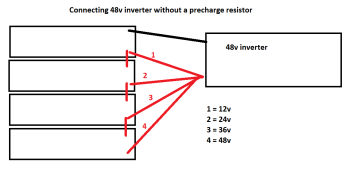The pre-charge resistor also protects the inverter from a massive in-rush of current. In many cases the large capacitors are mounted on a printed circuit board (copper trace usually built up with solder to increase current capacity). A large in-rush of current could potentially delaminate the copper trace from the underlying board.
Capacitors in DC Circuits
In dc circuits, when a dc voltage is first applied to a capacitor with no charge, it initially acts almost as a short circuit by allowing a maximum value of current to flow

en.wikipedia.org
Many BMS's have a pre-charge resistor built in. For me, with my SunGoldPower inverter's switch in the off position, I close the breaker on one EG4 LifePower4 battery which automatically uses a build in pre-charge resistor to charge the capacitors in the inverter and is does also prevent a large current from tripping the BMS



